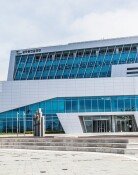Stream Restoration Will Cool Down Seoul
Stream Restoration Will Cool Down Seoul
Posted August. 12, 2005 03:04,
Once the restoration of Cheonggyechon, a stream in Seouls downtown, is completed, the temperature of the nearby area will be lowered by 3.6 degrees centigrade on average than other parts of Seoul according to data released on August 11 by the Seoul Municipal Development Institute (SMDI) on the D-50 day anniversary of the plan to restore the Cheonggye Stream set for October 1.
On July 27, when water was flowing in the Cheonggyechon, a thermal vision camera measured the temperature of 20 spots in the city, 10 around Cheonggye 8 St. including the Sung-in building, and 10 other inner city spots including Wangsan St. in Shinseoldong. According to the data, the average temperature around Cheonggye 8 St. was 32.7 degrees, while that of Wangsan St. was 36.3 degrees.
At 1:00 p.m. on the same day, a spot where water was flowing recorded a 27.7 degree temperature, a whopping 9.6 degrees lower than the nearby Wangsan St.s 37.3 degrees.
After the restoration project is completed and water flows full-scale, the stream will weaken Seouls heat island effect and lower the temperature of the inner city area.
According to the SMDI, the temperature will go down by 10 to 13 percent three to four degrees of reduction when it is 30 degrees in summer.
The SMDI also said that it was revealed that the temperature around Cheonggyechon was lower by 0.1 to 3.7 degrees on average in three tests on temperature of Cheonggye 4 St. and Jongno 5 St. conducted in 2004 and 2005 after the Cheonggye Speedway was removed.
A researcher of the SMDI said, Before the removal of Cheonggye Speedway, the temperature around Cheonggyechon was higher by five degrees or more than the average temperature of Seoul, adding, The removal of the overhead roads opened the way for winds and dropped the temperature, which was further decreased by water.
The SMDI compared and analyzed the heat island effect of the Cheonggyechon area on seven occasions from March 2003 to July 2005 with a thermal vision camera system.
The SMDI is expecting the heat island effect will further abate once the aquatic plants and road-side trees that were planted in Cheonggyechon grow.
There was a similar research result achieved by the Korea Forest Research Institute. According to three years of satellite vision analysis of the heat island effect in Daegu starting in 2002, the surface temperature of asphalt-covered roads and concrete buildings soared to 40 degrees, while that of the forestry area was as low as less than 20 degrees.
Jin-Han Lee Chin-Ku Lee likeday@donga.com sys1201@donga.com
Headline News
- N. Korea launches cyberattacks on S. Korea's defense companies
- Major university hospital professors consider a day off each week
- Italy suffers from fiscal deficits from ‘Super Bonus’ scheme
- Inter Milan secures 20th Serie A title, surpassing AC Milan
- Ruling and opposition prioritize spending amid tax revenue shortfalls







